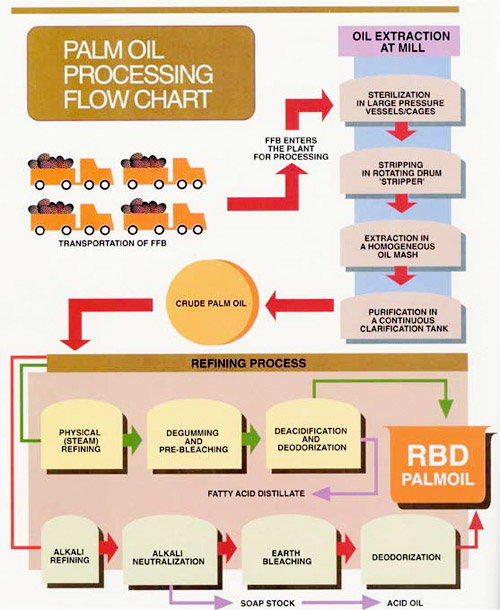Modern palm oil processing method
Modern processing of oil palm fruit bunches into edible oil is practiced using various methods which may be grouped into four categories according to their throughput and degree of complexity. These are the traditional methods, small-scale mechanical units, medium-scale mills and large industrial mills.
Generally, processing units handling up to 2 toones of fresh fruit bunches (FFB) per hour are considered to be small-scale. Installations that process between 2 and 8 toones FFB per hour are termed medium-scale, while large-scale redres to mills that process more that 10 toones per hour.

Machinery manufacturing is a recent development in the West Africa sub-region, and until recently it has not been possible to develop the sophisticated machines required to improve on traditional methods. Machinery manufacture in Africa must be carefully considered if progress is to be made in joining the rest of the industrialised world. Even now it is difficult to manufacture and sell bolts and coiled springs in the Central and West Africa sub-region. However, the manufacture of machines and combining them in the processing assemblies for small-scale rural industries is not within the scope of this publication. The main objective of this publication is to provide a detailed description of the various processes involved in small-scale palm oil processing, the tupe of machinery and equipment required, and their performance, energy and water consumption. The effect on the environment caused by waste and by-product uses is considered.
At the outset it must be stated that small-scale palm oil processing in the sub-region has systematically acquired sophistication, efficiency and reliability. It is agreed that traditional methods of extracting palm oil were inefficient and tedious for making oil for sale.
Generally women in the village are responsible for the processing and sale of fram produce. Small-scale agro-processing seems to hold the key to rural poverty reduction and the prolific oil palm tree provide the best raw material for starting rural industries.
Today small-scale processors who appreciate the value of using machines, are asking for them to be more sophisticated. Thus current demand for small-scale palm oil mills is shifting from simple stand-alone unit operational machines to a more integrated system which is easy to operate and maintain. Machinery manufacturers have responded with machines that combine several operations into one machine unit. The complete range of operation, oil drying and storage have been developed for small-scale processing applications. The processors can change and/or combine equipment to suit their purchasing power.
A by-product of palm oil extraction is the palm nut which, when cracked, yields a kernel containing a completely different kind of oil which can be used as a valuable substitute for cocoa butter. Unfortunately not many palm oil processors include palm kernel extraction at the same location. It is more usual that a completely different group undertakes palm kernel extraction.
To explain why this occurs, a description is included of how palm kernel oil is extracted and the relevant machinery and equipment needed, is indicated.